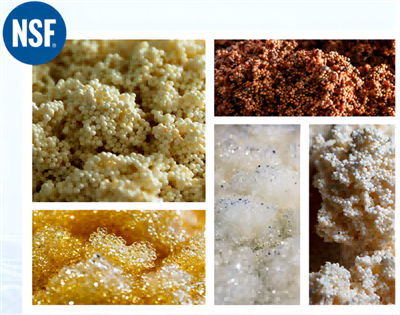Ion exchange resin is a polymer compound, so its performance is different due to the manufacturing process, raw material formulation, polymerization temperature, crosslinking agent, etc., its main performance can be divided into two parts.
(1) Physical properties
The appearance of the resin is a transparent or translucent substance, because of its different composition, the color is different, such as styrene resin is yellow, there are black and russet, but the effect on the use of performance is not large. Under normal circumstances, the raw material impurities or crosslinking agents are more, the color of the resin is slightly darker (but the resin in the operation process, because of various reasons sometimes the color will change). The shape of the resin is spherical, and the ball rate is required to reach more than 90%.
② The size of the particle size of the resin will affect the exchange rate, pressure loss, backwash effect, etc. The size of the particles should not vary too much. The particles of ion exchange resin used for water treatment should be 20 to 40 mesh. Particle size is indicated by effective particle size and non-uniformity coefficient.
③ The density is related to the water treatment process and the amount of resin filling. Density indication methods are: dry true density (generally about 1.6g/cm3), wet true density (generally between 1.04 and 1.30g/cm3), apparent wet density (generally between 0.60 and 0.80g/cm3).
The higher the water content of the resin, the larger the porosity and the smaller the crosslinking degree.
⑤ Swelling rate After soaking the resin should swell, which is related to the degree of crosslinking, active groups, exchange capacity, electrolyte solution density in water, and the properties of exchangeable ions. In the process of exchange and regeneration, the resin will expand and shrink, and it is easy to break after multiple expansion and contraction.
The wear resistance reflects the mechanical strength of the resin. It should ensure that the annual resin consumption does not exceed 7%.
⑦ The low polymer rich in the dissolved resin should be gradually dissolved, and colloidal dissolution will also occur during the use of the resin.
⑧ Heat resistant positive resin can withstand about 100℃, strong alkaline negative resin can withstand 60℃, weak alkaline negative resin can withstand 80℃. However, when it is lower than or equal to 0 ° C, it is easy to freeze and crumble.
⑨ Conductivity Dry resin does not conduct electricity, wet resin can be conductive.
(2) Chemical properties
① The mutual exchange reaction of ion exchange resin is also reversible, so it can be exchanged with each other, and can also be regenerated, and can be reused many times.
② It has acid and alkali. H+ type cation exchange resin and OH- type anionic exchange resin have the same properties as acid and base in electrolyte solution, and can ionize H+ and OH- in water.
③ With neutralization and hydrolysis performance. Because of its electrolyte solution properties, it can be neutralized with acids and bases, and can also be hydrolyzed.
④ The ability of ion exchange resin to absorb a variety of ions is different, but also selective.
⑤ Exchange capacity. It shows how much ions they exchange with each other. According to the shape of the resin, it can be divided into equilibrium exchange capacity, full exchange capacity, working exchange capacity, etc.


